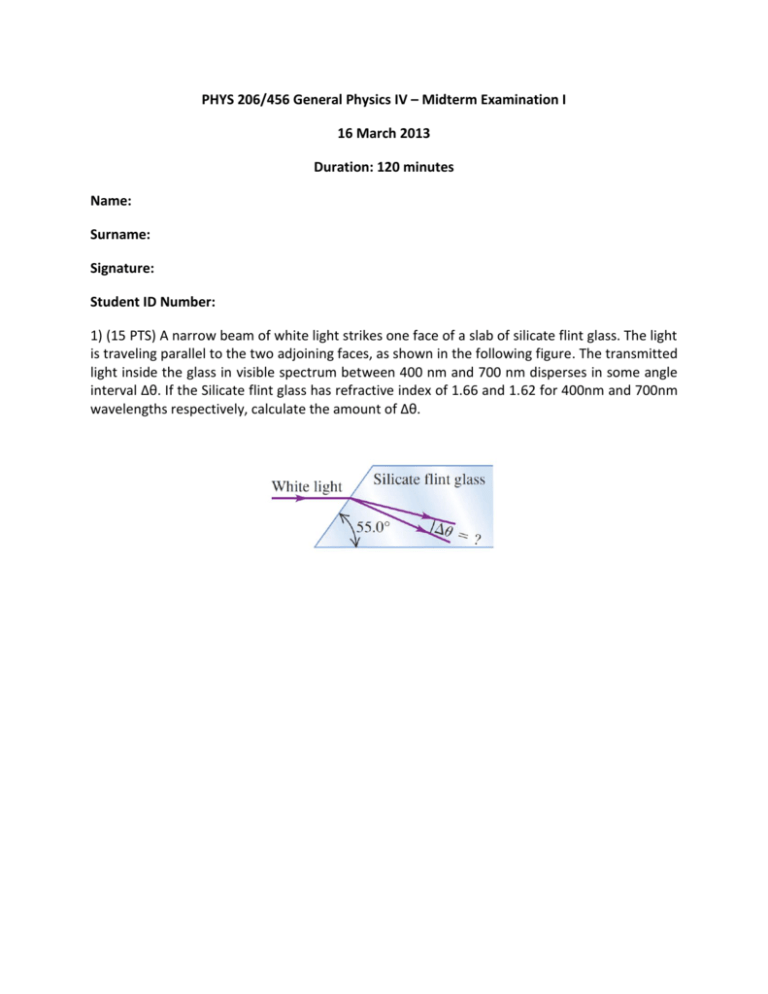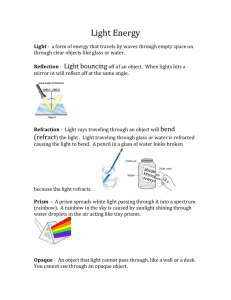PHYS 206/456 General Physics IV – Midterm Examination I 16
advertisement

PHYS 206/456 General Physics IV – Midterm Examination I 16 March 2013 Duration: 120 minutes Name: Surname: Signature: Student ID Number: 1) (15 PTS) A narrow beam of white light strikes one face of a slab of silicate flint glass. The light is traveling parallel to the two adjoining faces, as shown in the following figure. The transmitted light inside the glass in visible spectrum between 400 nm and 700 nm disperses in some angle interval ∆θ. If the Silicate flint glass has refractive index of 1.66 and 1.62 for 400nm and 700nm wavelengths respectively, calculate the amount of ∆θ. 2) (20 PTS) As shown in the figure below, a thick lens is formed by two spherical refractive interfaces (radius of curvature R1 and R2). The thickness of the lens is d. Assume a refractive index n for the material of the thick lens. Refractive index of outside is 1. a) Consider rays entering the thick lens from left and exiting from right. Calculate the total ray transformation matrix corresponding to the thick lens. b) Using the result in part a, find the effective focal length of a thick lens that is made of a full sphere with radius R. c) Using the result in part a, find the lensmaker’s equation. (You should evaluate the ray transformation matrix of the thick lens in the limit of very small thickness and compare the result with the ray transformation matrix of a thin lens. ) Hint: The ray transformation matrix for rays entering to a spherical refractive interface is: [ R1 d R2 ]. 3) (20 PTS) a) Consider refraction at a spherical surface. P, and P’ denote the positions of the object and image, respectively.Use the definitions given in the figure below and show that . b) Find the ray transformation matrix corresponding to refraction at a spherical surface for rays transmitted from medium a to medium b, as shown above. 4) (15 PTS) There is a point object inside a tube made of glass with refractive index of 1.5; one end of the tube is polished to make a spherical surface with 5 cm radius of curvature. Outside medium is air. If the object is 10 cm far from the apex of the spherical surface find the position of the image formed by the spherical surface. Is the image virtual or real? Hint: For refraction at a spherical surface n=1.00 n=1.5 Object . R=5cm 10cm 5) (15 PTS) The radius of curvature of the convex surface of a planoconvex lens is 68.4 cm. The lens is placed convex side down on a perfectly flat glass that is illuminated from above with red light having a wavelength of 580 nm. Find the diameter of the second bright ring in the interference pattern. R=68.4cm 6) (15 PTS) Laser light of wavelength 500.0 nm illuminates two identical slits, producing an interference pattern on a screen 90.0 cm from the slits. The bright bands are 1.00 cm apart, and the third bright bands on either side of the central maximum are missing in the pattern. Find the width and the separation of the two slits.







